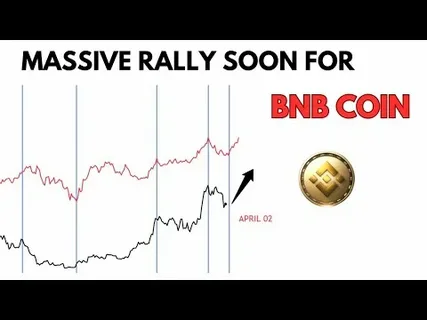Introduction
Binance Coin (BNB) has solidified its position as one of the leading cryptocurrencies in the market. As the native token of the Binance ecosystem, BNB plays a crucial role in trading fee discounts, staking, DeFi applications, and more. Over the years, its price has experienced significant fluctuations, making it a favorite asset for traders and investors seeking strategic entry points.
With the crypto market’s volatility, conducting a thorough technical analysis is essential for making informed decisions. This article provides a BNB Price Prediction, analyzing historical price trends, key support and resistance levels, and technical indicators that can help traders determine the best moments to buy or sell BNB.
If you are looking for insights into it’s potential future movements, keep reading as we explore a data-driven approach to predicting its price and identifying strategic entry points.

1. Historical Price Analysis of BNB
To develop a reliable BNB Price Prediction, we first need to analyze its historical performance. Understanding past trends can provide clues about how the asset might behave in the future.
Early Growth and Initial Surge
BNB was launched in 2017 at an initial price of around $0.10. Its value quickly gained traction as it became one of the leading crypto exchanges. By early 2021, it had reached $50, fueled by the broader crypto bull run.
The 2021 Bull Market and ATH
In May 2021, BNB reached its all-time high (ATH) of around $690. This surge was driven by:
-
Binance Smart Chain (BSC) Growth: Increased adoption of BSC for DeFi projects boosted it’s utility.
-
NFT Boom: The rise of NFTs and Binance’s entry into the NFT marketplace fueled demand.
-
Institutional Interest: Large-scale investors and hedge funds began taking positions in BNB.
Market Corrections and Bearish Trends
Like the rest of the crypto market, BNB experienced a sharp correction in mid-2021, dropping to nearly $250. Multiple factors, including regulatory challenges faced by Binance and overall market sentiment, contributed to this decline.
Recent Performance and Current Market Trends
As of 2024, BNB has been trading between $250 and $400, showing signs of accumulation. Understanding these fluctuations can help traders determine the best moments to enter or exit their positions.
2. Key Support and Resistance Levels
For traders looking to enter the BNB market strategically, identifying key support and resistance levels is crucial.
Support Levels
Support levels represent price points where buying pressure tends to increase, preventing further declines. Here are the major support zones for BNB:
-
$250 – $270: This range has historically acted as a strong base, as seen during previous market corrections.
-
$300 – $320: If BNB holds above this level, it could signal strong buying interest.
-
$200 (Psychological Support): A drop to this level could attract long-term investors looking for deep value entry points.
Resistance Levels
Resistance levels indicate where selling pressure could increase, making it difficult for the price to break higher.
-
$380 – $400: This has been a recent ceiling for BNB. A breakout above this level could trigger bullish momentum.
-
$500 – $520: If BNB reclaims this range, it could pave the way for a strong uptrend.
-
$600 – $690 (ATH Zone): Testing this level again would indicate a full recovery and potential for new highs.
Understanding these levels can help traders place strategic buy and sell orders to maximize their returns.
3. Technical Indicators for BNB Price Prediction
While historical trends and support/resistance levels provide valuable insights, using technical indicators can further refine BNB Price Prediction strategies. Here are some of the most effective indicators:
Moving Averages (MA)
-
50-Day Moving Average (50MA): Often used to identify short-term trends. If it is trading above the 50MA, it signals a bullish trend.
-
200-Day Moving Average (200MA): A key indicator for long-term trends. A crossover above the 200MA often confirms a strong uptrend.
Relative Strength Index (RSI)
The RSI helps determine whether it is overbought or oversold:
-
Above 70: Indicates overbought conditions, suggesting a potential price pullback.
-
Below 30: Indicates oversold conditions, which could signal a buying opportunity.
MACD (Moving Average Convergence Divergence)
The MACD indicator helps gauge momentum:
-
Bullish Crossover: When the MACD line crosses above the signal line, it indicates potential upward momentum.
-
Bearish Crossover: When the MACD line falls below the signal line, it signals possible downward movement.
Bollinger Bands
-
Price Near Upper Band: Suggests overbought conditions and a potential pullback.
-
Price Near Lower Band: Indicates oversold conditions, which may present a buying opportunity.
By combining these indicators, traders can develop a more accurate strategy for predicting it’s price movements.
4. Strategic Entry Points for BNB Traders
After analyzing historical data, key levels, and technical indicators, the next step is identifying strategic entry points.
Short-Term Trading Opportunities
For traders looking to capitalize on short-term price movements:
-
Buy Signal: If it is near key support levels and RSI is below 30, this could be an ideal time to enter.
-
Sell Signal: If BNB reaches major resistance and RSI is above 70, a pullback may be imminent.
Long-Term Investment Strategy
For long-term investors seeking a strong entry point:
-
Accumulation Zone ($250 – $320): This range offers a relatively low-risk entry point based on historical support.
-
Breakout Confirmation ($400 – $500): Entering after a confirmed breakout above resistance could provide higher returns.
Risk Management Strategies
Regardless of strategy, traders should always manage risk effectively:
-
Set Stop-Loss Orders: Placing stop-loss orders at key levels can protect against unexpected downturns.
-
Diversify Holdings: Avoid putting all capital into one asset to minimize potential losses.
-
Monitor Market Sentiment: Keeping an eye on news, regulations, and Binance’s developments can help anticipate price movements.
By applying these strategic entry points and risk management techniques, traders can improve their chances of making profitable decisions.
Conclusion
Making an accurate BNB Price Prediction requires a combination of historical analysis, technical indicators, and market sentiment assessment. Based on current trends, BNB is showing resilience, with key support and resistance levels defining potential entry and exit points.
For traders and investors, understanding these trends and indicators can lead to more informed decisions. Whether you’re looking for short-term trading opportunities or long-term investment strategies, applying the insights from this technical analysis can help optimize your portfolio.
Do you think BNB will break past its resistance levels soon? What’s your price prediction for the coming months? Share your thoughts in the comments below!







This Post Has One Comment